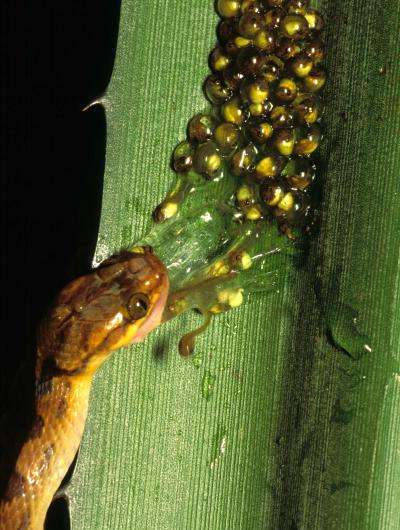How red-eyed treefrog embryos hatch in seconds (Update)

When they come under attack by a predatory treesnake, red-eyed treefrog embryos must escape in seconds or risk becoming lunch. However, most frog embryos take hours to hatch. Intrigued by the treefrogs rapid emergence, scientists from Boston University and the Smithsonian Tropical Research Institute have discovered that the minute escapologists rapidly release egg membrane degrading enzymes from their snouts, which digest a small hole in the structure through which the escapees can wriggle to freedom.
Enclosed in a case of moist jelly, most minute frog embryos take their time emerging from the protective coating; but not the spawn of tree dwelling Agalychnis callidryas (red-eyed treefrogs). When the eggs find themselves under attack by predatory snakes, the tiny embryos can burst out of their eggs in as little as 6s before dropping to safety in water below.
"This escape hatching is a mechanism for running away from a really important predator", says Karen Warkentin from Boston University, USA. But she was unsure how the tiny animals made their escape. Explaining that most frog embryos liberate themselves by releasing enzymes from hatching glands on their heads that slowly degrade the egg membrane, Warkentin thought that it was unlikely that treefrog embryos used the same approach, because the hatching process was so swift and the egg membrane remained largely intact. "We had seen them thrashing around and we thought they were somehow breaking out of the egg", she recalls. So when Mark Seid at the Smithsonian Tropical Research Institute, Panama, got access to a high-speed camera, Warkentin grasped the opportunity to reveal the mysteries of the treefrog embryos' escape in fine detail. Warkentin and her colleagues publish their discovery that the escapologist embryos rapidly release egg membrane degrading enzymes from their snouts that digest a small hole in the structure that the tiny escapee can wriggle through to freedom in Journal of Experimental Biology.
Fortunately, Warkentin and Seid had no difficulties collecting newly laid frog spawn from a nearby experimental pond overhung with accessible foliage. The duo then allowed the eggs to develop for 5days before gently prodding them to trigger breakouts. "One of the first and most interesting behaviours that we observed was shaking", recalls Kristina Cohen, who also noticed the embryos repeatedly opened and closed their mouths before the egg membrane ruptured. "Following this... you see fluid start to leak from the location in the membrane that is just in front of the embryo's snout", says Cohen, who recalls how the embryo then plugged the rupture by lodging its snout against it, before wriggling through in a bid for freedom. The embryos had made a hole in the membrane without even touching it. "Once we saw that, we thought it was probably enzymatic", says Cohen. But where was the enzyme being released from?
"We came up with this very low-tech experiment", says Cohen, describing how she spun the embryos around in the egg after they had been trembling and gaping for a few seconds to find out where the rupture formed: "If you don't perform the manipulation at the right time it doesn't work", says Cohen. However, when she timed the rotation perfectly, a hole appeared in the membrane next to where the embryo's snout had been originally located. The embryos must be releasing enzymes from somewhere on their heads to liberate themselves from the egg membrane.
Searching for hatching glands over the surface of the embryos' heads with a scanning electron microscope, Cohen successfully located tightly packed clusters of the glands on the embryos' snouts. Then, she painstakingly collected detailed scanning transmission electron microscopy images of the cells from embryos before they hatched and images of tadpoles immediately after they had successfully broken out. "Getting those images was indeed a lot of work", says Warkentin, recalling how Cohen's patience was eventually rewarded when the images revealed that the hatching gland vesicles had released their contents just seconds before hatching.
So, red-eyed treefrog embryos evade snake predators by rapidly releasing enzymes from hatching glands concentrated on the snout at one specific location to rupture the egg membrane and produce an aperture through which the embryo can wriggle in a matter of seconds in a life-and-death bid for survival.
More information: Cohen, K. L., Seid M. A. and Warkentin, K. M. (2016). How embryos escape from danger: the mechanism of rapid, plastic hatching in red-eyed treefrogs. J. Exp. Biol. 219, 1875-1883. DOI: 10.1242/jeb.139519
Journal information: Journal of Experimental Biology
Provided by The Company of Biologists



















